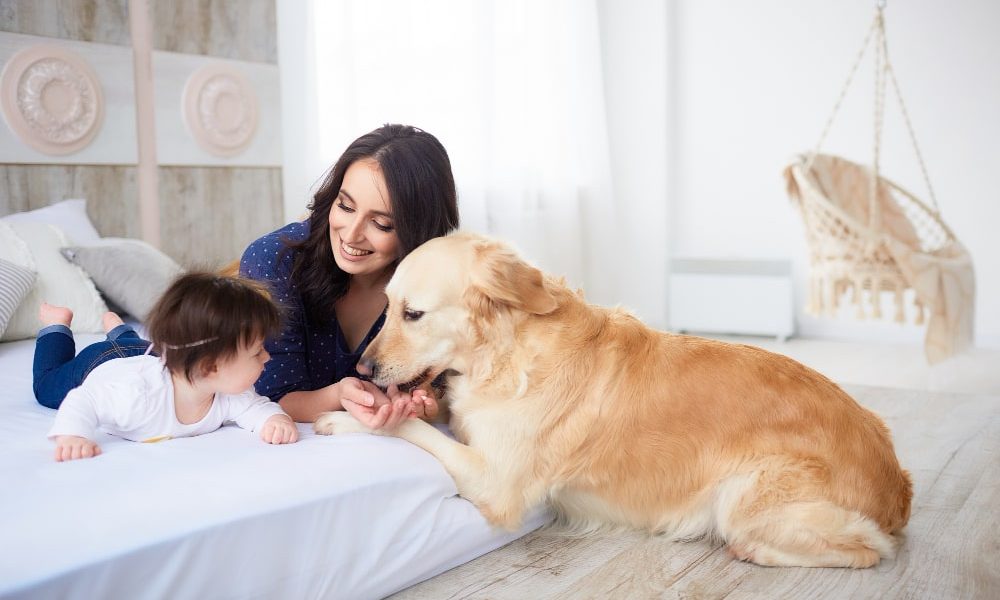Raising children constantly demands balance, and this can be a real challenge when they drain your energy emotionally. Even children may feel mood swings, loneliness, and anxiety, but adults can miss these symptoms. Dogs usually act as the silent helpers when everyone else is emotional. Having them around in a gentle way, always affectionate, and with structured routines helps them deal with stress and draws families closer. The French Bulldog is a friendly breed among small dogs known for being very loving and serene.
Read more:
- What are the Best Pet Birds for Families?
- Purr-fectly Raw: Nourishing Your Feline Friend with Raw Cat Food
Why Dogs Deserve a Deeper Look for Mental Wellness
Dogs impact the well-being of families in ways that go way beyond general companionship. They have a huge impact that is felt socially, emotionally, and developmentally, mainly for mothers and children. So, in the following sections, we will look into the different ways in which a dog can support mental and emotional health in everyday life.
Emotional Regulation for Moms Through Routine and Responsibility
Mothers are always burdened with stress, juggling between work, undergoing emotional labor, and offering care to their families. Introducing a dog into the household offers a better sense of well-being and structure around the space. Grooming, feeding, and walking offer a sense of regularity that moms often subconsciously crave. This set of predictable routines anchors their mental state.
For instance, a Teacup Bichpoo can adapt flawlessly to the lifestyle with its compact size and less-maintenance care. Following simple health and wellness tips for teacup Bichpoo, like setting consistent meal times and light exercise routines, supports a calmer household rhythm that the mothers often psychologically benefit from.
Anxiety Relief and Physical Comfort for Children
Young people with hyperactivity or anxiety often feel a lot better when there is a dog nearby. Petting a dog decreases stress hormones and encourages more trust to develop in our relationship with them.
The American Academy of Pediatrics conducted a study that found children with dogs are more protected against anxiety. This means they provide comfort during stressful changes at school or in the family.
If you raise your pup with care, feeding your dog a grain-free diet, for example, it will be much happier and easier for the kids to build healthy, genuine relationships with the animal.
Bonding and Communication Boosts in Family Dynamics
Dogs often personify a gentle bridge between family members, helping to encourage connection through shared care routines. Walking, feeding, and playtime offer the best possibilities for parents and children to collaborate to help foster teamwork and emotional closeness.
These regular interactions create pathways to spark conversations that may not happen otherwise, mainly during the times when you feel the peak of stress. Several families find themselves sitting together while their dogs play, sparking meaningful dialogue and mutual understanding.
The role of therapy dogs in mental health reveals how animals act as emotional mediators, not just in clinical settings but even at home. Even without special training, having a family dog around tends to ease stress, make children more understanding, and help them feel their needs are important.
Helping Children Develop Responsibility Through Routine
Dogs introduce well-structured daily habits that help the kids build a sense of responsibility. Regular tasks such as feeding, grooming, and walking a dog help establish accountability and consistency. Such routines not only encourage time management but instill emotional maturity as children care for other living beings.
A study from the National Institutes of Health suggests that looking after family pets during childhood increases young people’s self-confidence and improves their social abilities. As part of this journey, it is important to understand what your dog is trying to tell you, respond with empathy, and learn to read cues. Such skills change the way dogs interact with all that surrounds them.
Developing Emotional Intelligence in Kids
Growing up around dogs makes kids more likely to pick up on emotions. Having conversations with dogs, meeting their needs, and figuring out how they feel helps you learn emotional intelligence.
It is mainly evident across the expressive and gentle breeds. Exploring how to choose a dog breed leads families to options that align with their children’s temperament and needs. Whenever kids become part of your dog’s daily care, they start to learn care, consistency, and attentiveness, which are the skills to extend human relationships over time.
You can teach your dog through small, everyday actions, such as grooming, feeding, or looking for signs of mood changes. Dogs’ presence naturally helps people gain compassion and intuition.
Creating Soothing Environments for Kids with Sensory Challenges
Those with sensory processing problems usually find chaotic settings very hard to handle. The dog’s relaxed breathing and soothing fur are very comforting. If your kids have autism or ADHD, your pet dog acts as a shield for their senses and helps you with their emotions.
Small dog breeds such as the Frenchton are generally calm and predictable, which makes them suitable for families with kids. A well-tempered pet makes your kid feel comfortable and able to express themselves without having to speak. In moments when kids are very energetic or aggressive, dogs can help by getting physically close and distracting them.
Unspoken Companionship During Isolating Times
Transitioning to a new location, adjusting to remote learning, or experiencing family changes may leave both moms and children feeling lonely. During these isolating days, dogs help us feel at ease. They are steady and supportive, without needing to understand how we feel to be with us.
Moving, learning from home, and family changes can make moms and kids feel lonely, affecting both. Dogs stand by us for comfort when it’s easy to feel alone. Illusions exist as consistent, loving companions without asking you to explain your thoughts or feelings.
During these times, it’s great to have a friendly pet like the English Bulldog. Their tiny size allows pets to be lap cuddlers, giving families quiet and gentle ways to bond. In uncertain times, this kind of interaction holds us stable without saying much.
Building Emotional Resilience Through Nonverbal Connection
Dogs often communicate through body language, daily behaviors, and vocal tones as a form of expression, teaching kids and parents to stay in tune with emotional cues. It is beneficial to learn to notice their wagging tail, relaxed posture, or alert ears, building stronger awareness of nonverbal signals and often improving emotional regulation and empathy.
Research conducted by Johns Hopkins Medicine confirms that bonding with pets has the potential to reduce stress and build emotional resilience. Families often develop this type of silent, attentive connection, experiencing more harmony across regular interactions.
Reducing Screen Dependency and Encouraging Outdoor Play
For several families, spending hours in front of screens has become a routine. This is often at the cost of emotional and physical well-being. A dog often interrupts this cycle by naturally pulling children and parents into a more active, real-world engagement. Activities like going on a walk or tossing a ball introduce laughter, movement, and conversation.
These moments help promote healthier habits while creating an ideal space for bonding. Outdoor time with a dog encourages the kids to look up, move around, and interact completely with their space. Especially for parents, it is the much-needed break that can help restore balance and presence in daily life.
Conclusion
Dogs offer more than just companionship. They bring an emotional depth, calming influence, and steady presence that fit naturally into any family life. Their ability to connect with adults and children creates a much better space where emotional support is within reach. Regular interactions such as play, walks, or quiet moments on the couch build a better sense of comfort and reliability that words fail to express. Families in search of balance, connection, and warmth often find a dog to become an irreplaceable part of their emotional world.

